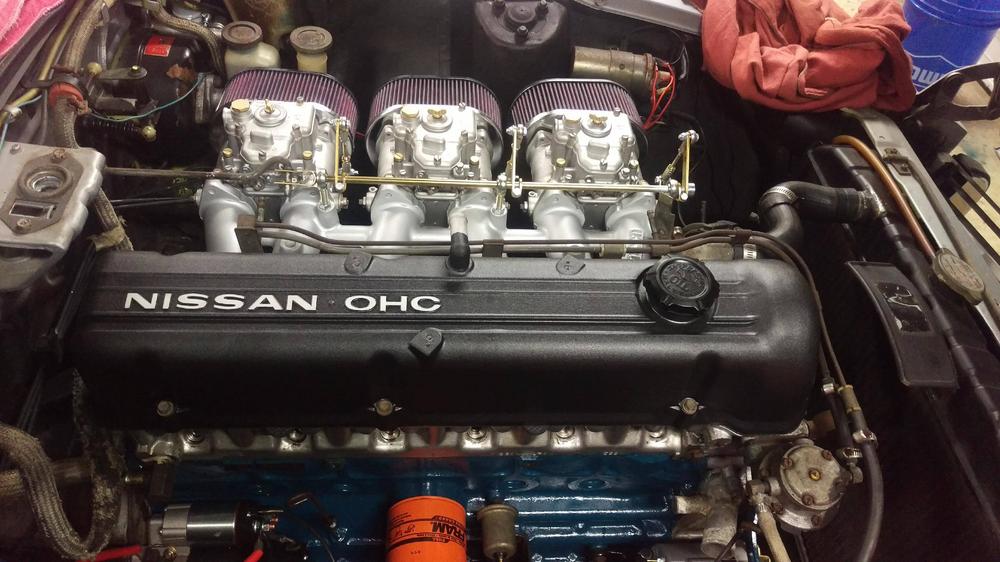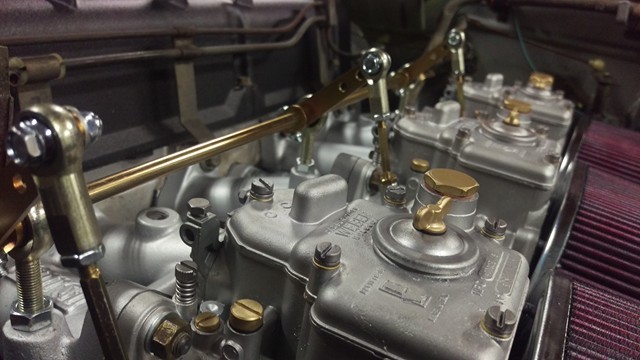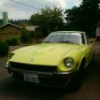Search the Community
Showing results for tags 'Triple'.
-
Good evening guys, So I'm back for more help. It's almost time to drive my 240z for the first time, but the clutch is stuck to the flywheel. You might remember me. I'm the guy who bought the 72 with a seized engine(that I got unstuck). I'm here because the engine has a really hard time running when engine cold. It's about 60 degrees in Chicago now . So it will start and revs to about 2500 for 2 seconds and shut off, try again and again the same thing. Over and over and over again for about 5 minutes. I'm messing with the throttle the whole time. After a few minutes of that , it runs and idle great! Other that a slight bog when I blip off idle. Sorry for the long story, just want to give some background. Thanks in advance guys
-
First off i want to thank everyone that has helped me with my project 240. So it starts!! Now trying to tune and sync the carbs. Having trouble with a super high idle aroung 1300rpm with timing set advanced around 12 degrees, any lower and the car diesels and backfires. the engine revs smooth unless you blip the throttle , in which case it bogs for a sec and climbs. i have not driven it yet(still need work on suspension and brakes). any other guys with webers have any input on this? as far as timing? what dizzy to go with? also, the lights flickers and ammeter goes nuts in car. does not happen all the time, it does smooth out and when it goes crazy, there is a slight squealing noise in engine bay. All and any input is greatly appreciated
- 14 replies
-
- high idle
- lights flicker
-
(and 3 more)
Tagged with:
-
I'm setting up triple 45s with the cannon manifold and conversion kit and I hit a snag. The plate that the throttle linkages connect to on each carb is so close that the head of the bolt holding them together hits a mounting point on the carb. I was thinking I would just flatten out this point since it's not needed and move on with my life. Do I just have it set up slightly wrong or is this common?
-
We just bought a 1974 260z with triple carbs. However, they are locked up and unusable. Is there a solution to unlocking them? Also, if we have to replace them, what is the difference in the Weber triple carb and Mikuna triple carb?
-
Disclaimer: I am by NO means a Weber Pro and this post is still a WIP (Work in Progress) Hello, my name is Mike and I've recently tackled my first set of Triple DCOE Webers project. Now, I spent hours reading all the manuals and following a few guides online, but none of them were particularly methodical in their approach and often just led to more confusion. I'm putting this guide together to, hopefully, help others who might not have much experience with these carbs or for those who (like me) prefer a Step-by-Step approach to figuring things out. This guide has been made possible with the help of those more knowledgeable than me. Thanks guys - you know who you are! If there's anything I need to clarify or add, let me know. Table of Contents I. Documentation II. Useful Links/Parts/Accessories III. Prologue IV. Choke/Venturi V. Main Jets, Emulsion Tubes, Air Correctors & Idle Jets VI. TBD I. Documentation DCOE Weber Carburetor Top-View Layout Weber Factory Tuning Manual - Download Link Power Tuning Webers (Des Hammil/Veloce Publishing) - Download Link Selection and Tuning of DCOE Weber Carbs (David Andrews ) - Download Link Weber DCOE Tuning Manual (Philippe Boursin) - Download Link II. Useful Links/Parts/Accessories http://www.redlineweber.com/ http://www.piercemanifolds.com/ http://www.carburetion.com/index.htm III. Prologue - The First Date First and foremost, it is essential that you know what you're working with. Setup a date with your newly acquired friends and spend a romantic evening just getting to know each other - perhaps light some candles and pour some wine while you're at it. In order to tune them properly, you need to know what sort of equipment your carbs are packing. IV. Choke/Venturi - Step One - Removal Let's start off by determining the size of the chokes/venturis. (If carbs don't have filters on them, skip to Step 1D) If the carbs are already out, the easiest way is to shine some light down the carb and see if you spot the engraved number. If you can't see the number or if you want to replace the chokes, then follow these steps. 1A - Unscrew the airbox/filter (If applicable) 1B - Underneath there are four (8mm) bolts holding in the housing. I already took off one of the studs. 1C - Remove Gasket (If applicable) 1D - Unscrew the this little fella (11mm) sitting on the bottom corner of each side of the carburetor. This holds the auxiliary venturi in place. 1E - Once the screw is removed, the aux. venturi should slip right out. 1F - Make a note of the little indent where the screw holds the aux. venturi in place. You're gonna have to put it back the same way for it to seat properly 1G - You should be able to see the chokes now, but we're gonna replace the 28's with a different size. 1H - Unscrew this fella (I used a flathead) to allow the choke to slide out. 1I - If you're having some trouble getting the choke/venturi out, then open the butterflies and push it out from the opposite side. It'll otherwise slide out IV. Choke/Venturi - Step Two - Assembly Alright, so now we have removed the choke - it's time to replace them! Here's the old 28 next to the new 34 that is going in. 2A - See these notches? You want to make sure that they line up properly in the carb. Looking at the carb from the front, the left choke lines up at 12 & 3, while the right choke lines up at 12 & 9 (Left choke lined up at 12 & 3) 2B - Re-insert the screw and make sure it sits firm. I had some trouble getting the right angle on some of them, so just make sure it's lined up properly. 2C - The aux. venturi should slide right in. Remember that little indent from before? Make sure it lines up properly with where the screw goes. 2D - Screw the little guy (11mm) back in and double check to make sure the aux. venturi is seated properly 2E - Do one final inspection to make sure everything is sitting right and then continue to put your gasket and filter back on. Personally, I went with these stacks. They slide right in and uses little clips that slide into the studs to hold them in. V. Main Jets, Air Correctors, Emulsion Tubes & Idle Jets WIP - Work in Progress
-
Hello all from Australia, Long time browser, first time poster here because I finally can't find the information I'm looking for! First off, my name's Adam and I have a 1973 240z which is currently running a standard L28, N42 head/block combo, with brand new triple 45mm OER carburetors, and Trust headers to a twin 2" exhaust system. I have just installed a new set of OER carbs I purchased from Japan and am having difficulties sorting out the idle/low speed cruise setting. Bit of details into the setup, 45mm carbs 34mm venturis #190 air correctors (not yet tested to see if these are the best) #130 mains #60 idles #40 pump nozzle #1.8 needle valve 3.5psi fuel pressure from the mechanical fuel pump into Holley regulator 31mm fuel level using the OER level gauge. Idle screws are setup so that the first progression hole is just 100% covered looking through the brass cap/inspection hole. Carbs are balanced the best I can using a unisyn. I have a wide-band O2 sensor probe in the tail pipe. I am running 98 octane fuel. Timing is at 15 BTDC with no vacuum advance connected. Valve clearances have recently been adjusted. Now, onto the problem I am having.. Driving with the #60 idles installed, 1 full turn of the mixture screw turned out, slow acceleration and cruise is very rich, 10.5 and 11.5 AFRs respectively. I also have #50 idles on hand which I have installed to try and improve the current rich scenario and I cannot even get them to idle. With mixture screws out 1.5 full turns (recommended range is only 3/4 to 1 full turn), they cannot idle on their own, only when I blimp the throttle which I believe is activating the pump jets. With the #50s installed, AFRs are off the scale in the lean area. They can't idle let alone drive. My question is, is going down from a #60 to a #50 idle jet that big of a jump that the car can no longer idle on its own? Or is there something wrong with my idle screw setup? OER offer a #55, but I would like to double check with the experts out there first before spending that money. Any help would be appreciated. And please let me know if I am missing some information, I tried to be as detailed as possible. Thanks, Adam
-
Hey y'all. Sorry, I don't know much about forum ettiquette as this is the first one I've joined.The guy said that everything under the hood was perfect, but after driving it for a week, I'm seeing that the carb intakes are leaking gas and the gaskets leading into the engine are wet with gas as well. I'm kind of a novice (at the Forum thing as well as owning a datsun/working on my car) so any pointers would be appreciated! I really want to do the car justice! - Josh Info: Original Engine - 90k miles Idle - 1500, sometimes dips down to lower 1000s Anything else that's relevant?
-
Hey so I don't know that much about cars so don't kill me if this Q is dumb. I was wondering what the benefits of switching out my SUs with triple weber carbs. What are advantages and disadvantages. any help would be great thx.
- 15 replies
-
- 240z
- carburetor
-
(and 1 more)
Tagged with:





